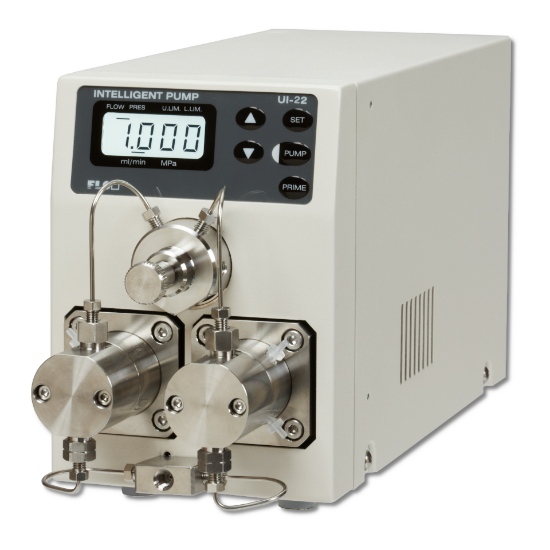HPLC pump Overview
HPLC Pump Overview
Modern HPLC pumps feature various technologies from decades of development. Several pump components and design elements are critical to determining pump usage and performance. It is therefore quite useful to have some understanding of important features if you will be using HPLC pumps regularly.
In this article, we provide an overview of the key features of HPLC pumps. This includes a discussion on different pump types, layouts, modes of operation, and other features of interest.
Table of Contents
- What is an HPLC pump and what is it used for
- Pump types
- Dual pump heads and layout
- Drive motors
- Multisolvent HPLC Pumps
- Fluidic path materials
.png)
1. What is an HPLC pump and what is it used for
The HPLC pump is a specialized pump system for delivering mobile phases through HPLC columns at high pressures (magnitudes of 6,000 psi or 400 bar for HPLC to 22,000 psi or 1,500 bar in UHPLC). It is also called the solvent delivery system. HPLC pumps today have been refined through decades of development to be able to deliver mobile phases while meeting the rigorous requirements for precise and accurate practice of high performance liquid chromatography including
- Consistent generation of high-pressure
- Produce a stable flow rate with a high degree of control
- Minimal pulsation
- Compatibility with common solvents
- Accurately mix solvents
- High endurance for cost-effective operation
Most modern HPLC pumps are precisely manufactured equipment made out of high-quality inert materials and equipped with advanced electronic drives. Features for ease of use for the practitioner are also included by manufacturers including controls and displays on the front panel, a compact design, and common hardpoints for expansion and mounting.
2. Pump types
Syringe pump
The syringe pump is comprised of a filled chamber that is sealed during operation which is pumped using a motor. Because the container is sealed, there is only a limited amount of mobile phase that can be delivered per load. Loading the syringe also takes some time. This type of pump is only useful today for portable applications where the syringe chamber and motor are available in an integrated, compact package, and having a large volume of the mobile phase is not so important.
Piston pump
The piston pump is a type of reciprocating pump which is a pump with an intake and discharge cycle. A piston pump has a chamber that is loaded and compressed by a piston. Unlike the syringe pump, the piston pump is open with an inlet and an outlet port which are regulated by valves. The open chamber allows for a more compact chamber, overall, compared to the syringe pump. The moving part of this pump is the piston head which contacts the inner wall of the pump head. To ensure that high pressure is created, a high-pressure seal is used that encircles the piston head.
Piston pumps are a popular type of pump for HPLC, producing high-pressure reliably. However, a drawback with piston pumps is that they experience significant pulse.
Plunger pump
The plunger pump is very similar to the piston pump; rather than a piston head, a plunger head is used to create pressure. The plunger pump is another type of reciprocating pump. The plunger is a rod that compresses the space inside the pump head without making contact with the inner diameter of the chamber.
A critical difference between the plunger and piston-type pumps is how they are sealed. The only contact between the plunger and the cylinder and the only point where the moving part of the pump is sealed is at the end of the cylinder. The plunger pump seals are stationary, unlike the piston pump. The seals experience much less friction and less wear and are able to take higher pressures. This allows the plunger pump to operate at higher pressures than the piston pump and is usually used more in UHPLC. Pulse, however, is still a common issue.
Roller pump
Roller pumps produce pressure from rollers in a wheel to push fluid inside compressible tubing. Unlike other pump types, the fluid never comes into contact with any other surface of the pump aside from the tubing. Roller pumps produce much less pressure than other pump types (in the magnitude of kPa instead of MPa) and are mainly used only for basic pumping applications such as cleaning other pumps.

Intelligent Pump UI-22,
GL Sciences HPLC pump
High-performance LC pump featuring superior flow control with linear drives

Roller Pump WP-21, GL Sciences HPLC pump
For plunger pump maintenance and basic pumping applications
3. Dual pump heads and layout
The piston pump and plunger pump, are the most popular pump types for HPLC but pulsation is a common concern from reciprocating pumps. Pulse can be reduced in several ways: using a pulse damper, an elastic chamber that absorbs some of the energy to reduce the pulse, but a better solution for pulse is a dual pump head design which uses two pump heads to continuously flow mobile phase through the column.
There are two implementations of the dual pump head design: series and parallel.
Series
A series layout places two pump heads in sequence. The primary piston (which is closer to the inlet) fills both the secondary piston while feeding solvent to the column. After the primary piston ends its discharge cycle, the secondary piston begins its own discharge cycle and the accumulated solvent is delivered to the system. In this way, there is no gap to which solvent is delivered to the column and pulsation is minimized. There is greater wear on the primary piston due to it running twice the cycles of the secondary piston but the series layout has the advantage of requiring fewer check valves, lessening possible points of failure.
Parallel
In parallel two pump heads are both connected to the column inlet and take turns delivering the mobile phase. The pump heads may powered by the same drive or be independently controlled with individual drives. The parallel layout provides equal wear to both pump heads. The usual disadvantage with the parallel layout is that would require more check valves than the series layout, as each individual pump requires its own pair of inlet and outlet valves but an electronically moderated switching valve can be used instead.
.png)
Dual Plunger Pump KP-22,
GL Sciences HPLC pump
General-use pump for set volume dispensing or constant pressure applications with pressure sensor

Single Plunger Pump SP-22,
GL Sciences HPLC pump
Low-cost, simple to operate single plunger pumps for pulsed and steady-state flow

Pulse Damper for HPLC pumps,
GL Sciences
For controlling pulsation at high or low pressures
4. Drive Motors
Very briefly, the type of drives for HPLC pumps are discussed. All drives effectively perform the same function in HPLC pumps but are differentiated by level of performance. The main implication here for end-users is the price, with most manufacturers using higher-performing, more expensive drives on more expensive models.
There are two implementations of the dual pump head design: series and parallel.
Linear/Screw
The linear or screw drive is powered by a motor that uses a threaded screw to provide compression. It also allows for deeper plunger strokes than comparably sized cam motors. Each pump head will need to be independently powered by individual motors but this also means independent control of the pump heads is a given feature with this drive type.
Cam
The cam drive utilizes a round cam to generate reciprocating motion. This drive can power two pump heads and, thus, is more cost-effective than linear drives. However, this does not provide as fine control to the pumping motion as linear drives. Also, the stroke length is not as deep as comparably sized linear drives due to the rotary action of the cam producing vibration.

Intelligent Pump UI-22,
GL Sciences HPLC pump
High-performance LC pump featuring precision flow control with linear drives

Dual Plunger Pump KP-22,
GL Sciences HPLC pump
General-use pump for set volume dispensing or constant pressure applications with pressure sensor

Dual Plunger Pump KP-21,
GL Sciences HPLC Pump
For controlling pulsation at high or low pressures
5. Multisolvent HPLC Pumps
HPLC pumps operate in two modes: isocratic mode, where there is no mixing in the solvent, and gradient mode, where solvents are mixed. A single pump block, commonly referred to as an isocratic pump, is usually the only one needed for isocratic mode. The pump is lined with a pre-mixed solvent and there is no variation in the concentration of the solvent. In gradient mode, the two or more mobile phases are mixed through the pump setup. The concentration may vary throughout a run.
There are two set-ups for gradient mode: low-pressure mixing and high-pressure mixing. Both modes have respective advantages and disadvantages with respect to convenience and cost.
High-pressure mixing
In high-pressure mode, two (or more) high-pressure pumps are connected downstream to a mixer, a valve that accepts and combines several high-pressure solvent lines. Two pumps used in high-pressure mixing are called binary pumps. High-pressure mixing allows for a small delay in the delivery of the mixed solvent due to low dwell volume, which is the volume from the point in the system wherein solvents are mixed to the entrance of the column. High-pressure gradient mode also provides high accuracy of the solvent composition and is the preferred set-up for UHPLC. The main downside with the high-pressure set-up is the cost, as a minimum of two pump blocks are necessary, along with tubing and space requirements.
Low-pressure mixing
In low-pressure gradient mode, a proportionating valve is used to feed multiple lines of rate-controlled solvents to the pump. In contrast to high-pressure mixing, the mixing of solvents does not happen downstream but in the pump volume itself. This produces a much higher dwell volume and significant delay in solvent delivery as compared to the high-pressure set-up. Also, less control of solvent composition is achieved with this setup. The benefit of low-pressure mixing is cost, as it only uses one pump block. It is also more convenient, in another way, as it requires less space and is less complicated to use than a high-pressure set-up.
6. Fluidic path materials
Different types of materials are available for all the components in the solvent line of HPLC pumps for compatibility with various solvents. Common materials include polychlorotrifluoroethylene (PCTFE), polyetheretherketone (PEEK), and stainless steel. Various materials will have different pressure ceilings.
Maximum pressures supported by pumps produced by GL Sciences
| Material | PCTFE | PEEK | SS |
| Max Pressure | 2 MPa (290 psi) | 5-20 MPa (725-2900 psi) | 5-35 MPa (725-5075 psi) |
| Incompatible solvents | tetrahydrofuran halogenated solutions under high temp | tetrahydrofuran halogenated solutions strong acids | strong acids certain inorganic salts |

Intelligent Pump UI-22 Stainless steel,
GL Sciences HPLC pump
Intelligent Pump version with Stainless Steel pump head material and Max pressure of 35 MPa (5075 psi)

Intelligent Pump UI-22 PCTFE,
GL Sciences HPLC pump
Intelligent Pump version with PCTFE pump head material and Max pressure of 2 MPa (290 psi)

Intelligent Pump UI-22 PEEK,
GL Sciences HPLC Pump
Intelligent Pump version with PEEK pump head material and Max pressure of 20 MPa (2900 psi)
Need Help Finding The Right HPLC Pump?
Leave a comment


 Español (Taducido por Google)
Español (Taducido por Google)






